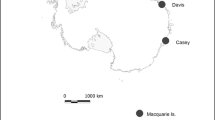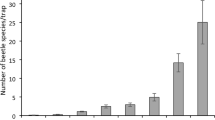Abstract
Despite the significance of invertebrate species in the alien and invasive faunas of both sub-Antarctic and, increasingly, some Antarctic locations, little information exists on the numbers and identity of species being transported to the Antarctic region. Here we provide information on a decade (2006/2007–2016/2017) of detections in the surveillance program established at Scott Base in the Ross Sea region of continental Antarctica. The program found 233 individuals in 134 detection events, belonging to at least 14 Orders and 51 Families. Among these were alien, pest and synanthropic species recorded elsewhere on the globe or in the broader Antarctic region. These included sciarid flies known to have established in station sewage-treatment plants elsewhere on the continent. Flies, spiders and moths were most commonly detected, and typically in food (60% of interceptions), and then in clothing and equipment (11%), aircraft and cargo (11%) and packaging material (11%). Detected groups were similar to those found in the two other extensive surveillance efforts (King George Island and East Antarctica), highlighting the need to continue and improve surveillance across the region. For invertebrates, further control of the supply chain prior to embarkation of cargo and personnel may be the most effective management option to prevent further transport of non-indigenous species to the Antarctic.



Similar content being viewed by others
References
Anonymous (2008) Non-native species incursions at Scott Base, Antarctica. Information paper 75, Antarctic Treaty Consultative Meeting XXXI. www.ats.aq
Anonymous (2017) Inter-Parties’ action plan to manage the non-native flies in King George Island, South Shetland Islands. Working paper 26, Antarctic Treaty Consultative Meeting XL. www.ats.aq
Beggs JR, Brockerhoff EG, Corley JC, Kenis M, Masciocchi M, Muller F, Rome Q, Villemant C (2011) Ecological effects and management of invasive alien Vespidae. BioControl 56:505–526
Bell JR, Bohan DA, Shaw EM, Weyman GS (2005) Ballooning dispersal using silk: world fauna, phylogenies, genetics and models. Bull Entomol Res 95:69–114
Bradshaw CJA, Leroy B, Bellard C, Roiz D, Albert C, Fournier A, Barbet-Massin M, Salles J-M, Simard F, Courchamp F (2016) Massive yet grossly underestimated global costs of invasive insects. Nat Commun 7:12986
Brockerhoff EG, Kimberley M, Leibhold AM, Haack RA, Cavey JF (2014) Predicting how altering propagule pressure changes establishment rates of biological invaders across species pools. Ecology 95:594–601
Caley P, Ingram R, de Baro P (2015) Entry of exotic insects into Australia: does border interception count match incursion risk? Biol Invasions 17:1087–1094
CEP (2017) Non-native species manual. Antarctic Treaty Secretariat, Buenos Aires. http://www.ats.aq/documents/ATCM40/att/atcm40_att056_e.pdf. Accessed 20 March 2018
Chown SL, Convey P (2016) Antarctic entomology. Annu Rev Entomol 61:119–137
Chown SL, Language K (1994) Recently established Diptera and Lepidoptera on sub-Antarctic Marion Island. Afr Entomol 2:57–76
Chown SL, Huiskes AHL, Gremmen NJM, Lee JE, Terauds A, Crosbie K, Frenot Y, Hughes KA, Imura S, Kiefer K, Lebouvier M, Raymond B, Tsujimoto M, Ware C, Van de Vijver B, Bergstrom DM (2012) Continent-wide risk assessment for the establishment of nonindigenous species in Antarctica. Proc Natl Acad Sci USA 109:4938–4943
Chwedorzewska KJ, Korczak-Abshire MO, Lityńska-Zając M, Augustyniuk-Kram A (2013) Alien invertebrates transported accidentally to the Polish Antarctic Station in cargo and on fresh foods. Pol Polar Res 34:55–66
COMNAP (2010) COMNAP/SCAR non-native species voluntary checklists for supply chain managers. COMNAP Secretariat, Christchurch. https://www.comnap.aq/SitePages/checklists.aspx. Accessed 20 March 2018
Convey P, Key RS, Key RJD (2010) The establishment of a new ecological guild of pollinating insects on sub-Antarctic South Georgia. Antarct Sci 22:508–512
Denlinger DL, Lee RE (2010) Low temperature biology of insects. Cambridge University Press, Cambridge
Duffy GA, Coetzee BWT, Latombe G, Akerman AH, McGeoch MA, Chown SL (2017) Barriers to globally invasive species are weakening across the Antarctic. Divers Distrib 23:982–996
Engels B (2015) XNomial: exact goodness-of-fit test for multinomial data with fixed probabilities. R package version 1.0.4. https://CRAN.R-project.org/package=XNomial
Field GD, Sampath AP (2017) Behavioural and physiological limits to vision in mammals. Philos Trans R Soc B 372:20160072
Frenot Y, Chown SL, Whinam J, Selkirk PM, Convey P, Skotnicki M, Bergstrom DM (2005) Biological invasions in the Antarctic: extent, impacts and implications. Biol Rev 80:45–72
Gaston KJ, Chown SL, Mercer RD (2001) The animal species-body size distribution of Marion Island. Proc Natl Acad Sci USA 98:14493–14496
Greenslade P, Potapov M, Russell D, Convey P (2012) Global collembola on Deception Island. J Insect Sci 12:1–16
Grimaldi D, Engel MS (2005) Evolution of the insects. Cambridge University Press, Cambridge
Houghton M, McQuillan PB, Bergstrom DM, Frost L, van den Hoff J, Shaw J (2016) Pathways of alien invertebrate transfer to the Antarctic region. Polar Biol 39:23–33
Hughes KA, Convey P (2010) The protection of Antarctic terrestrial ecosystems from inter- and intra-continental transfer of non-indigenous species by human activities: a review of current systems and practices. Glob Environ Change 20:96–112
Hughes KA, Convey P (2012) Determining the native/non-native status of newly discovered terrestrial and freshwater species in Antarctica—current knowledge, methodology and management action. J Environ Manag 93:52–66
Hughes KA, Walsh S, Convey P, Richards S, Bergstrom DM (2005) Alien fly populations established at two Antarctic research stations. Polar Biol 28:568–570
Hughes KA, Convey P, Maslen NR, Smith RIL (2010) Accidental transfer of non-native soil organisms into Antarctica on construction vehicles. Biol Invasions 12:875–891
Hughes KA, Lee JE, Tsujimoto M, Imura S, Bergstrom DM, Ware C, Lebouvier M, Huiskes AHL, Gremmen NJM, Frenot Y, Bridge PD, Chown SL (2011) Food for thought: risks of non-native species transfer to the Antarctic region with fresh produce. Biol Conserv 144:1682–1689
Hughes KA, Pertierra LR, Molina-Montenegro MA, Convey P (2015) Biological invasions in terrestrial Antarctica: what is the current status and can we respond? Biodivers Conserv 24:1031–1035
Huiskes AHL, Gremmen NJM, Bergstrom DM, Frenot Y, Hughes KA, Imura S, Kiefer K, Lebouvier M, Lee JE, Tsujimoto M, Ware C, Van de Vijver B, Chown SL (2014) Aliens in Antarctica: assessing transfer of plant propagules by human visitors to reduce invasion risk. Biol Conserv 171:278–284
Hullé M, Pannetier D, Simon J-C, Vernon P, Frenot Y (2003) Aphids of sub-Antarctic Îles Crozet and Kerguelen: species diversity, host range and spatial distribution. Antarct Sci 15:203–209
Hulme PE (2009) Trade, transport and trouble: managing invasive species pathways in an era of globalization. J Appl Ecol 46:10–18
Jenkins JA, Mizell RF III, Van Bloem S, Whitmire S, Wiscovitch L, Zaleski C, Goenaga R (2014) An analysis of arthropod interceptions by APHIS-PPQ and Customs and Border Protection in Puerto Rico. Am Entomol 60:44–55
Kearney M, Porter WP (2009) Mechanistic niche modelling: combining physiological and spatial data to predict species’ ranges. Ecol Lett 12:334–350
Kift NB, Mead A, Reynolds K, Sime S, Barber MD, Denholm I, Tatchell GM (2004) The impact of insecticide resistance in the currant-lettuce aphid, Nasonovia ribisnigri, on pest management in lettuce. Agric For Entomol 6:295–309
Lebouvier M, Laparie M, Hullé M, Marais A, Cozic Y, Lalouette L, Vernon P, Candresse T, Frenot Y, Renault D (2011) The significance of the sub-Antarctic Kerguelen Islands for the assessment of the vulnerability of native communities to climate change, alien insect invasions and plant viruses. Biol Invasions 13:1195–1208
Lee JE, Chown SL (2009) Breaching the dispersal barrier to invasion: quantification and management. Ecol Appl 19:1944–1959
Leung B, Bradie J (2017) Estimating non-indigenous species establishment and their impact on biodiversity using the Relative Suitability Richness model. J Appl Ecol 54:1978–1988
Leung B, Springborn MR, Turner JA, Brockerhoff EG (2014) Pathway-level risk analysis: the net present value of an invasive species policy in the US. Front Ecol Environ 12:273–279
Lockwood JL, Cassey P, Blackburn TM (2009) The more you introduce the more you get: the role of colonization pressure and propagule pressure in invasion ecology. Divers Distrib 15:904–910
McGeoch MA, Shaw JD, Terauds A, Lee JE, Chown SL (2015) Monitoring biological invasion across the broader Antarctic: a baseline and indicator framework. Glob Environ Change 32:108–125
McGeoch MA, Genovesi P, Bellingham PJ, Costello MJ, McGrannachan C, Sheppard A (2016) Prioritizing species, pathways, and sites to achieve conservation targets for biological invasion. Biol Invasions 18:299–314
McNeill M, Phillips C, Young S, Shah F, Alders L, Bell N, Gerard E, Littlejohn R (2011) Transportation of nonindigenous species on international aircraft passengers’ footwear. Biol Invasions 13:2799–2815
Molina-Montenegro MA, Carrasco-Urra F, Rodrigo C, Convey P, Valladares F, Gianoli E (2012) Occurrence of the non-native annual bluegrass on the Antarctic mainland and its negative effects on native plants. Conserv Biol 26:717–723
Pertierra LR, Aragon P, Shaw JD, Bergstrom DM, Terauds A, Olalla-Tarraga MA (2017) Global thermal niche models of two European grasses show high invasion risks in Antarctica. Glob Change Biol 23:2863–2873
Pugh PJA (1994) Non-indigenous acari of Antarctica and the sub-Antarctic islands. Zool J Linn Soc 110:207–217
Pugh PJA (2004) Biogeography of spiders (Araneae: Arachnida) on the islands of the Southern Ocean. J Nat Hist 38:1461–1487
Pugh PJA, Scott B (2002) Biodiversity and biogeography of non-marine Mollusca on the islands of the Southern Ocean. J Nat Hist 36:927–952
Rogan-Finnemore M (ed) (2008) Non-native species in the Antarctic. Gateway Antarctica, Christchurch
Rust MK (2008) Urban entomology. In: Capinera JL (ed) Encyclopedia of entomology. Springer, Dordrecht, pp 4027–4031
Simberloff D, Martin JL, Genovesi P, Maris V, Wardle DA, Aronson J, Courchamp F, Galil B, García-Berthou E, Pascal M, Pyšek P, Sousa R, Tabacchi E, Vilà M (2013) Impacts of biological invasions: what’s what and the way forward. Trends Ecol Evol 28:58–66
Sokal RR, Rohlf FJ (2012) Biometry: the principles and practise of statistics in biological research, 4th edn. W.H. Freeman, New York
Tatem AJ (2009) The worldwide airline network and the dispersal of exotic species: 2007–2010. Ecography 32:94–102
Terauds A, Chown SL, Morgan F, Peat HJ, Watts DJ, Keys H, Convey P, Bergstrom DM (2012) Conservation biogeography of the Antarctic. Divers Distrib 18:726–741
Vicente JR, Alagador D, Guerra C, Alonso JM, Kueffer C, Vaz AS, Fernandes RF, Cabral JA, Araújo MB, Honrado JP (2016) Cost-effective monitoring of biological invasions under global change: a modelling framework. J Appl Ecol 53:1317–1329
Volonterio O, Ponce de León R, Convey P, Krzemińska E (2013) First record of Trichoceridae (Diptera) in the maritime Antarctic. Polar Biol 36:1125–1131
Ward DF, Beggs JR, Clout MN, Harris RJ, O’Connor S (2006) The diversity and origin of exotic ants arriving in New Zealand via human-mediated dispersal. Divers Distrib 12:601–609
Watson AB, Ahumada AJ (2005) A standard model for foveal detection of spatial contrast. J Vis 5:717–740
Whinam J, Chilcott N, Bergstrom DM (2005) Subantarctic hitchhikers: expeditioners as vectors for the introduction of alien organisms. Biol Conserv 121:207–219
Acknowledgements
Carol Muir, Senior Technician Entomology, Plant Health and Environment Laboratory at the Ministry of Primary Industries in Christchurch undertook the species identifications. Melanie Newfield, Manager, Plants and Pathways Risk Assessment, Ministry for Primary Industries, Wellington was instrumental in setting up invertebrate surveillance. Two anonymous reviewers provided helpful comments on a previous version of the work. SLC and RIL were supported by Australian Antarctic Science Grant 4307.
Author information
Authors and Affiliations
Corresponding author
Electronic supplementary material
Below is the link to the electronic supplementary material.
Rights and permissions
About this article
Cite this article
Newman, J., Poirot, C., Roper-Gee, R. et al. A decade of invertebrate colonization pressure on Scott Base in the Ross Sea region. Biol Invasions 20, 2623–2633 (2018). https://doi.org/10.1007/s10530-018-1722-3
Received:
Accepted:
Published:
Issue Date:
DOI: https://doi.org/10.1007/s10530-018-1722-3




